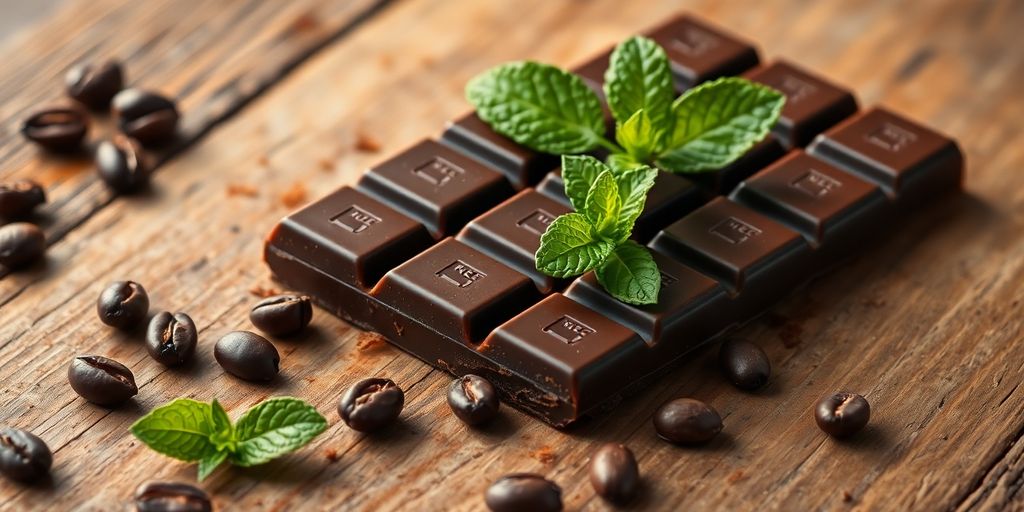Alright, so you’re keen on finding a healthy dark chocolate that actually tastes good, right? It’s not just about grabbing any old block from the supermarket shelf. We’re talking about finding the good stuff, the real deal, that’s not only a treat for your tastebuds but also does a bit of good for your body. Stick around, and we’ll suss out how to pick a ripper healthy dark chocolate, what makes it stand out, and some top-notch brands to look out for.
Key Takeaways
- Look for healthy dark chocolate with a high cacao percentage, usually 70% or more, for the best benefits.
- Check the ingredients list; fewer ingredients mean a purer, healthier dark chocolate.
- Prioritise brands that focus on ethical sourcing and fair trade practises for their cacao beans.
- Healthy dark chocolate isn’t just for snacking; it’s also a great ingredient for baking.
- Be aware of unnecessary additives like extra sugars or hydrogenated fats when choosing your healthy dark chocolate.
Unearthing the Best Healthy Dark Chocolate
Finding a top-notch healthy dark chocolate can feel like a treasure hunt, but it’s a delicious one! It’s about more than just grabbing the first bar you see. We’re aiming for quality, flavour, and ethical production. Let’s get started.
The Cacao Percentage Sweet Spot
When it comes to healthy dark chocolate, the cacao percentage is king. Generally, you’ll want to aim for 70% cacao or higher. This ensures you’re getting a good dose of antioxidants and less of the added sugars and fats that can negate the health benefits. But remember, higher isn’t always better – it’s about finding the balance that suits your taste buds. Some people love the intense bitterness of 85% or even 90%, while others prefer the slightly sweeter notes of 70-75%.
Beyond the Bar: Versatility in Use
Dark chocolate isn’t just for snacking straight from the wrapper (though that’s perfectly acceptable, of course!). Its rich flavour makes it incredibly versatile in the kitchen. Think about using it in:
- Baking: Choc chip cookies, brownies, or even a decadent chocolate cake. The higher cacao content adds depth and complexity.
- Hot chocolate: A much healthier alternative to store-bought mixes. Just melt some dark chocolate into warm milk for a rich, comforting drink.
- Dessert sauces: Drizzle melted dark chocolate over fruit, ice cream, or even pancakes for a touch of indulgence.
Choosing a versatile dark chocolate means you can enjoy its health benefits in a variety of ways, making it a staple in your pantry.
The Ethical Bean: Sustainable Sourcing
It’s important to consider where your chocolate comes from. Look for brands that prioritise sustainable sourcing and fair trade practises. This ensures that the farmers who grow the cacao beans are treated fairly and that the environment is protected. Certifications like Fairtrade, Rainforest Alliance, and UTZ are good indicators, but it’s also worth researching the brand’s specific sourcing policies. After all, a healthy chocolate bar should be good for both you and the planet.
Decoding the Dark Chocolate Difference

The Art of Cacao Origin
The origin of the cacao bean plays a massive role in the final flavour profile of your dark chocolate. Just like wine, the terroir – the soil, climate, and environment where the cacao is grown – significantly impacts the taste. For example, cacao from South America might offer fruity and floral notes, while beans from Africa could lean towards earthy and robust flavours. Understanding cacao origin allows you to appreciate the nuances and complexities within different dark chocolate bars. It’s not just about the percentage; it’s about where those beans came from!
Flavour Profiles and Palate Pleasure
Dark chocolate isn’t just one-dimensional; it boasts a wide array of flavour profiles. You might encounter notes of:
- Red berries
- Citrus
- Spice
- Nuts
- Earthy undertones
These flavours develop during fermentation, roasting, and conching. The skill of the chocolatier in controlling these processes is what brings out the best in the beans. Exploring different flavour profiles is part of the fun! Some people prefer a bold, intense flavour, while others enjoy a more subtle, nuanced experience. It’s all about finding what tickles your tastebuds.
Texture Talk: From Silky to Snappy
Texture is just as important as flavour when it comes to enjoying dark chocolate. A good quality bar should have a satisfying snap when you break it. This indicates proper tempering, which is the process of stabilising the cocoa butter crystals. The mouthfeel can range from silky smooth to slightly grainy, depending on the conching process (a mixing process that refines the chocolate). Some people love a melt-in-your-mouth experience, while others prefer a bit more texture. It’s a matter of personal preference. If you are looking for a creamy and approachable organic dark chocolate, consider Equal Exchange Organic.
The texture of dark chocolate can be a real indicator of quality. A gritty or crumbly texture might suggest issues with the manufacturing process, while a smooth, even texture usually points to a well-crafted bar.
Top Picks for a Healthy Dark Chocolate Fix
AMANO’s Artisan Excellence
Okay, let’s talk about some seriously good dark chocolate. First up, we have AMANO. Their artisan approach really shines through in their chocolate. It’s not just a bar; it’s an experience. The care they put into sourcing and crafting their chocolate is evident from the first bite. You can taste the quality, and that’s what sets it apart. It’s a bit fancy, sure, but sometimes you just need that little bit of luxury, right?
Divine Chocolate: A Fair Trade Delight
Divine Chocolate is another top contender, and it’s all about fair trade. It’s not just about the taste (which is great, by the way); it’s about the ethics behind it. Knowing that the farmers are getting a fair deal makes that chocolate taste even better. They’ve got a range of flavours, so there’s something for everyone. Plus, it’s pretty easy to find in most supermarkets, which is always a bonus. If you’re after fair trade chocolate, Divine is a solid choice.
Theo’s Ethical and Accessible Indulgence
Theo’s is where ethical meets accessible. They’re committed to sustainable practises, and their chocolate is actually pretty easy to get your hands on. It’s not too expensive, and the quality is consistently good. They’ve got a good range of cacao percentages, so you can find something that suits your taste. It’s a great option if you want something that’s both delicious and responsible. I reckon Theo’s is a great option for accessible indulgence.
Finding a chocolate that ticks all the boxes – taste, ethics, and accessibility – can be a bit of a challenge. But these three brands definitely stand out. They’re all doing things the right way, and their chocolate is proof of that. So next time you’re craving a dark chocolate fix, give one of these a go. You won’t be disappointed.
Strong Contenders in the Dark Chocolate Arena
While our top picks represent the pinnacle of healthy dark chocolate, several other brands deserve recognition. These contenders might have missed the top spots due to minor shortcomings, but they still offer a delightful and health-conscious indulgence.
TCHO Dark Duo: A Decadent Treat
TCHO’s Dark Duo is designed for snacking. These compact bars combine two types of chocolate: a fruity Peruvian cacao inside a fudgy Ghanaian chocolate shell. The result is a decadent flavour and texture, with hints of coffee, cherry, and butter. While we enjoyed almost everything about this bar, some found the umami flavour a bit too intense, overshadowing the more subtle fruit notes.
Equal Exchange Organic: Creamy and Approachable
Equal Exchange Organic Very Dark Chocolate offers a good balance of price, ingredients, and cocoa content. We appreciated the smooth, creamy texture. However, opinions varied on the aftertaste, with some detecting bitter or chalky notes. It’s a solid, approachable option for those new to dark chocolate.
Beyond Good: Madagascar’s Unique Flavour
Beyond Good sources its cacao from Madagascar, resulting in a unique flavour profile. The chocolate often exhibits bright, fruity notes that set it apart from other dark chocolates. It’s a great choice for those seeking something a little different. The company also focuses on ethical sourcing, supporting farmers in Madagascar.
Choosing dark chocolate is a personal journey. Consider your flavour preferences, ethical concerns, and intended use. These strong contenders offer a range of options to explore, ensuring you find a bar that satisfies your cravings and aligns with your values.
Here’s a quick comparison of these contenders:
| Brand | Cacao Percentage | Key Features |
|---|---|---|
| TCHO Dark Duo | 75% | Dual-chocolate layers, fruity and fudgy |
| Equal Exchange | 71% | Creamy texture, approachable flavour |
| Beyond Good | Varies | Unique Madagascar cacao, fruity notes |
If you’re looking for gluten-free food that doesn’t compromise on taste, these dark chocolate options can be a great addition to your diet.
What Makes a Healthy Dark Chocolate Shine?

Minimal Ingredients for Maximum Goodness
When you’re sussing out a good block of dark chocolate, less is definitely more. The fewer ingredients listed, the better the quality generally is. You really just want to see cacao (or cocoa) mass, cocoa butter, and maybe a touch of sugar. Avoid anything with a laundry list of additives, artificial flavours, or excessive amounts of milk solids. You’re aiming for pure, unadulterated chocolatey goodness. Think of it like this: the simpler the recipe, the more the cacao origin can truly shine through.
The Importance of Ethical Sourcing
Knowing where your chocolate comes from is a big deal. The cocoa industry has had its fair share of issues with fair labour practises, so looking for chocolate that’s ethically sourced is super important.
Here’s what to look for:
- Fair Trade Certification: This ensures farmers receive a fair price for their beans.
- Direct Trade: Some companies work directly with farmers, cutting out the middleman and ensuring more money goes to the source.
- Sustainable Farming Practises: Look for brands that support environmentally friendly farming methods.
Supporting ethical brands means you’re not just treating yourself; you’re also helping to support communities and protect the environment. It’s a win-win situation, really.
Beyond Snacking: Baking and Beyond
Dark chocolate isn’t just for scoffing straight from the block (although, let’s be honest, that’s a pretty great way to enjoy it). It’s also a fantastic ingredient for all sorts of culinary adventures. Think about it:
- Baking: Dark chocolate adds a rich, intense flavour to brownies, cakes, and biscuits.
- Desserts: Melt it down for a decadent chocolate sauce or use it to make truffles.
- Savoury Dishes: Yep, you can even use dark chocolate in savoury dishes! A little bit can add depth and complexity to sauces for meat or chilli.
Here’s a quick guide to healthy dark chocolate uses:
| Use | Cacao Percentage | Notes |
|---|---|---|
| Snacking | 70-85% | A good balance of flavour and health benefits. |
| Baking | 60-70% | Melts well and adds a good chocolate flavour without being too bitter. |
| Sauces | 70-85% | Adds a rich, intense flavour. Use sparingly. |
Navigating the World of Healthy Dark Chocolate
Understanding Cacao Content
Okay, so you’re standing in the chocolate aisle, staring at a wall of dark chocolate bars. The first thing you’ll probably notice is the percentage on the front. This is the cacao content, and it’s a big deal. The higher the percentage, the more cacao and generally, the less sugar. But it’s not just about going for the highest number you can find. It’s about finding what you enjoy. A super high percentage might be too bitter for some, while a lower one might not give you that intense dark chocolate hit you’re after. Experiment a bit!
Identifying Unnecessary Additives
Turn that bar around and have a squiz at the ingredients list. The shorter, the better, usually. You’re ideally looking for cacao beans (or cacao mass), sugar, and maybe some cocoa butter and vanilla. Anything else? Well, it might be unnecessary. Things like milk solids, hydrogenated fats, or artificial flavourings are often added to make the chocolate cheaper or to change the texture, but they don’t really add anything good from a health perspective.
The Impact of Bean Processing
How the cacao beans are processed can actually make a difference to the final product. Some processes can strip away some of the good stuff, like the antioxidants. Look for chocolate that’s been minimally processed to retain as much of the natural goodness as possible. You might see terms like ‘stone-ground’ or ‘raw’ cacao, which often indicate a gentler processing method. It’s worth doing a bit of digging to find out how different brands handle their beans. Also, consider the health benefits of dark chocolate.
It’s easy to get caught up in the numbers and labels, but remember that taste is subjective. What one person considers the perfect dark chocolate, another might find too bitter or not rich enough. The best way to find your favourite is to try a few different bars and see what you like. Don’t be afraid to experiment with different brands, cacao percentages, and origins until you find your perfect match.
Wrapping It Up: Your Dark Chocolate Journey
So, there you have it, folks! Picking a good dark chocolate isn’t just about grabbing the first block you see. It’s a bit like finding a good bottle of wine, really. You want to look at where the cacao comes from, how much of it is in there, and what kind of taste it’s got. We tried a bunch of them, focusing on the ones with at least 70% cacao and not too many extra bits. Hopefully, this helps you find your new favourite, whether it’s for a sneaky afternoon treat or something fancy after dinner. Happy munching!
Frequently Asked Questions
How do I pick a healthy dark chocolate?
When you’re picking a healthy dark chocolate, look for a high cacao percentage, ideally 70% or more. Also, check the ingredients list. The shorter, the better! You want to see cacao, cocoa butter, and a bit of sugar, not a bunch of extra stuff like milk solids or weird fats.
Is dark chocolate actually good for you?
Absolutely! Dark chocolate, especially with a high cacao content, is packed with antioxidants. These are good for your heart and can help reduce inflammation. Just remember, it’s still chocolate, so enjoy it in moderation.
What’s the deal with cacao percentage?
A higher cacao percentage usually means less sugar and more of the good stuff like antioxidants. It also means a stronger, more bitter chocolate taste. So, if you’re new to dark chocolate, you might start with 70% and work your way up.
Why is ‘ethical sourcing’ important for chocolate?
Ethical sourcing means the cacao beans are grown and harvested in a way that’s fair to the farmers and good for the environment. Look for certifications like Fair Trade or direct trade relationships, which often mean farmers get a better deal and sustainable practises are used.
Can I use healthy dark chocolate for baking?
You bet! Dark chocolate is super versatile. You can munch on it as a snack, melt it down for a delicious fondue, or chop it up and add it to your favourite baking recipes, like cookies or cakes. The richer the chocolate, the more intense the flavour it’ll add.
How much dark chocolate should I eat in a day?
While dark chocolate has health benefits, it’s still a treat. A small square or two a day is a good amount. Think of it as a healthy indulgence, not something to gobble down a whole block of in one go!





